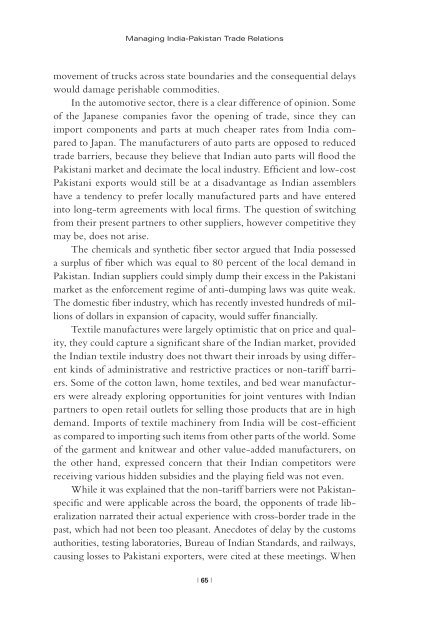Create successful ePaper yourself
Turn your PDF publications into a flip-book with our unique Google optimized e-Paper software.
Managing <strong>India</strong>-<strong>Pakistan</strong> <strong>Trade</strong> Relations<br />
movement of trucks across state boundaries and the consequential delays<br />
would damage perishable commodities.<br />
In the automotive sector, there is a clear difference of opinion. Some<br />
of the Japanese companies favor the opening of trade, since they can<br />
import components and parts at much cheaper rates from <strong>India</strong> compared<br />
to Japan. The manufacturers of auto parts are opposed to reduced<br />
trade barriers, because they believe that <strong>India</strong>n auto parts will flood the<br />
<strong>Pakistan</strong>i market and decimate the local industry. Efficient and low-cost<br />
<strong>Pakistan</strong>i exports would still be at a disadvantage as <strong>India</strong>n assemblers<br />
have a tendency to prefer locally manufactured parts and have entered<br />
into long-term agreements with local firms. The question of switching<br />
from their present partners to other suppliers, however competitive they<br />
may be, does not arise.<br />
The chemicals and synthetic fiber sector argued that <strong>India</strong> possessed<br />
a surplus of fiber which was equal to 80 percent of the local demand in<br />
<strong>Pakistan</strong>. <strong>India</strong>n suppliers could simply dump their excess in the <strong>Pakistan</strong>i<br />
market as the enforcement regime of anti-dumping laws was quite weak.<br />
The domestic fiber industry, which has recently invested hundreds of millions<br />
of dollars in expansion of capacity, would suffer financially.<br />
Textile manufactures were largely optimistic that on price and quality,<br />
they could capture a significant share of the <strong>India</strong>n market, provided<br />
the <strong>India</strong>n textile industry does not thwart their inroads by using different<br />
kinds of administrative and restrictive practices or non-tariff barriers.<br />
Some of the cotton lawn, home textiles, and bed wear manufacturers<br />
were already exploring opportunities for joint ventures with <strong>India</strong>n<br />
partners to open retail outlets for selling those products that are in high<br />
demand. Imports of textile machinery from <strong>India</strong> will be cost-efficient<br />
as compared to importing such items from other parts of the world. Some<br />
of the garment and knitwear and other value-added manufacturers, on<br />
the other hand, expressed concern that their <strong>India</strong>n competitors were<br />
receiving various hidden subsidies and the playing field was not even.<br />
While it was explained that the non-tariff barriers were not <strong>Pakistan</strong>specific<br />
and were applicable across the board, the opponents of trade liberalization<br />
narrated their actual experience with cross-border trade in the<br />
past, which had not been too pleasant. Anecdotes of delay by the customs<br />
authorities, testing laboratories, Bureau of <strong>India</strong>n Standards, and railways,<br />
causing losses to <strong>Pakistan</strong>i exporters, were cited at these meetings. When<br />
| 65 |


